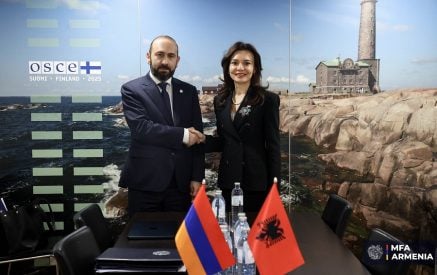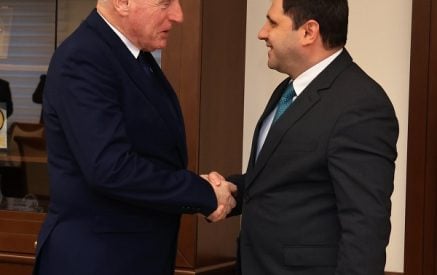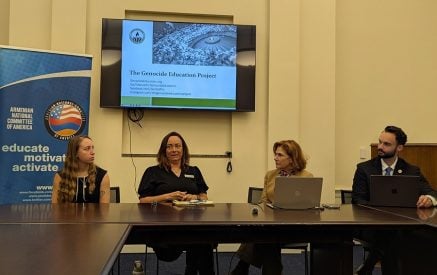BY DORIS AND ARDA MELKONIAN
Continents apart, two international conferences examine genocidal suffering and devastation, as well as its aftermath, through cutting edge research.
“The Ottoman Genocide of Christian Populations: Armenians, Assyrians and Greeks,” hosted by the Chair of Pontic Studies, convened at the Alexandros Papanastasiou Hall, from May 10 to 12 at the Aristotle University of Thessaloniki in Greece. The rolling hillside, once a former Jewish cemetery and only a minute’s walk from the Aegean Sea, is now the site of a higher education institution.
The gravity of the setting unfolds as the historic significance of the conference venue for this momentous occasion is revealed. Thessaloniki (Salonica) served as the headquarters of the Young Turks Committee of Union and Progress. The conference on the Ottoman Genocide of Christian populations convened in the very hall in which the fate of these ethnic groups was debated and planned.
For this congregation of Armenian, Assyrian, and Greek scholars, the irony is great. Several individuals – descendants of genocide survivors – presented in the hall where the trajectory of the lives of their ancestors was altered. The scholars who are direct descendants of genocide survivors, representing a link between research and the reality of genocide, include Arda Melkonian, Doris Melkonian, and Khatchig Mouradian.
The conference featured prominent historians, Professor Taner Akçam and Professor Richard Hovannisian, whose prolific publications have shaped the Armenian Genocide field. In their keynote addresses, Professor Akçam examined “The Anatomy of Ottoman Genocide,” and Professor Hovannisian discussed the “Evolving Approaches to the Study of Genocide: The Armenian Case.”
The range of scholarship, by Armenian scholars, included survivor testimony analyses, as well as examination of legal and criminal aspects of the genocide. The following is a list of Armenian presenters and their paper titles: Anna Aleksanyan, “Mass Rape and Body Destruction of the Armenian Women During the Genocide;” Armine Badalyan, “The Necessity of Civilizational Protection of Cultural Monuments in the Context of Current Developments in the Middle East;”
Regina Galustyan, “A Step towards Identity Construction or Genocide? Ideological Transformations in the Ottoman Empire in 1911 – 1913;” Dr. Edita Gzoyan, “Reclamation of Armenian and Greek women and children after the Genocide: the Efforts of the League of Nations;” Dr. Anush Hovhannisyan, “The 1914 Cleansing of Aegean Greeks as a Trial Run for the Deportation of Armenians;” Dr. Anahit Khosroeva, “Official Genocidal Policy of the Young Turks’ State: The Assyrian Case;” Dr. Ohannes Kiliçdaği, “Time and Space Problematics in Studying Genocides: The Armenian Case;” Arda Melkonian “Genocide Narratives of Separation, Reunion and Recovery;” Doris Melkonian, “Tattooed: Boundaries of Inclusion and Exclusion;” and Dr. Khatchig Mouradian, “Unarmed and Dangerous: Humanitarian Resistance during the Ottoman Genocides.”
From l to r: Dr. Suren Manukyan, Doris Melkonyan, Arda Melkonyan, Dr. Panos Stavrianidis at the Cambodian Genocide Memorial
From l to r: Dr. Suren Manukyan, Doris Melkonyan, Arda Melkonyan, Dr. Panos Stavrianidis at the Cambodian Genocide Memorial
A special session was dedicated to the memory of Professor Speros Vryonis, Jr. (1928 – 2019), an American historian of Greek descent, specialist in Byzantine, Balkan, and Greek history, former UCLA history professor, and supporter of Armenian studies.
The bilingual conference concluded with the inauguration ceremony of the Research Center of Pontic Studies and the Black Sea Archive at Aristotle University of Thessaloniki.
The hospitality of the Pontic Studies department, under the direction of Professor Theodosios Kyriakidis and the collegial interaction, contributed to making this a memorable conference.
On the 40th anniversary of the Cambodian Genocide, Phnom Penh, Cambodia was the backdrop for the 14th Biennial Conference of the International Association of Genocide Scholars, which was held from July 14 to 19. The setting served as a reminder of a bloody period in Cambodian history from 1973 to 1979. Under the reign of Pol Pot and his cadre of loyal followers, the Khmer Rouge reshaped the Cambodian landscape. The grizzly tortures coupled with mass killings targeted the Cambodian intellectuals and upper class, as well as the Cham people and Vietnamese. During the five-year period, 1.5 to 2 million individuals were exploited as slave labor, tilling the rice fields and building dams that provided the lifeline for the country. The ruthless crimes that led to merciless killings altered the landscape, annihilating a quarter of Cambodia’s population at the time.
The scars from this recent period of violence are evident throughout the country as torture sites remain intact and memorials stand erect. In a city of contrasts, the past is juxtaposed against the present. Tuol Sleng, the former secondary school turned torture chamber and Security Prison 21, forms part of the cityscape. The enclosed cells, the torture mechanisms, and the compound all reek of death. The surrounding barbed wires bear witness to the inescapability of this reality.
Severely tortured, individuals were sent to the killing fields to meet their final fate. In one of the killing fields, hovering over the site, a memorial Buddhist stupa bears witness to the atrocities. Incased in the glass stupa are hundreds of skulls hammered, pierced, and smashed in, reverently placed on floating shelves. Once discarded, the skeletal remains of mandible, femurs, and bone fragments reveal the torture endured by the individuals. The unearthing process continues to this day as layers of earth are shifted organically, producing the remains and personal belonging of its victims. The site is a living memorial.
The week-long conference, themed “‘The Missing Picture:’ Rethinking Genocide Studies and Prevention,” commenced with the keynote address by Professor Cynthia Enloe of Clark University in the historic Chaktomuk Theatre where, in 1979, former Khmer Rouge leaders were tried and convicted in absentia for the Cambodian Genocide. The Cambodian Genocide was highlighted at the conference through the venue, movie screenings, as well as presentations.
Although the Cambodian Genocide was highlighted throughout the conference, a handful of luminary Armenian Genocide scholars participated in the conference and kept the Armenian Genocide in dialogue. Presenting a range of papers addressing legal to psychological issues were: Dr. Henry Theriault (current President of IAGS), “Truly Transformative Repair: Reparations as Social Justice and Movement;” Dr. Peter Balakian, “Ingesting Violence: Poetry, Poetics and Atrocity Testimony;” Dr. Armen Marsoobian, “The Social Self and Social Death: Rethinking Reparations in the Aftermath of Genocide;” Dr. Suren Manukyan, “Armenian Genocide Studies: Roots and Trends;” Arda Melkonian, “Resisting Attempts to Recreate Identity During the Armenian Genocide;” Doris Melkonian, “Untold Stories: A Comparison of Women’s Experiences During the Armenian Genocide and the Holocaust;” and Hrag Yacoubian, “The Armenian Genocide Narrated by Canadian Women and the Globe.”
In this setting, intact with genocidal evidence and memorials, scholars specializing in various genocides gathered to discuss the subject and its impact on victims and subsequent generations. Among the 14 international IAGS conferences, this one had the second highest number of participants, attracting scholars from diverse disciplines and distant lands.






















































